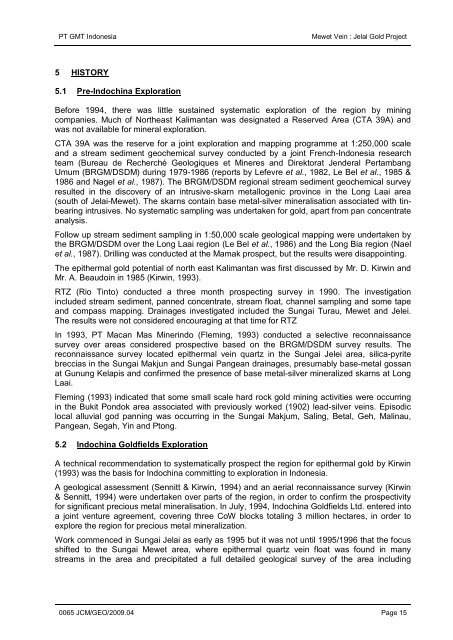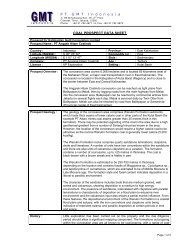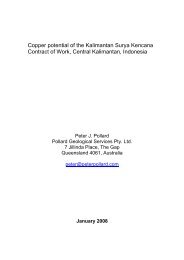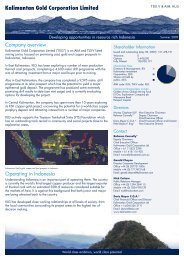Geology and mineralisation of the Mewet Vein, Jelai Gold Project ...
Geology and mineralisation of the Mewet Vein, Jelai Gold Project ...
Geology and mineralisation of the Mewet Vein, Jelai Gold Project ...
You also want an ePaper? Increase the reach of your titles
YUMPU automatically turns print PDFs into web optimized ePapers that Google loves.
PT GMT Indonesia<br />
<strong>Mewet</strong> <strong>Vein</strong> : <strong>Jelai</strong> <strong>Gold</strong> <strong>Project</strong><br />
5<br />
5.1<br />
HISTORY<br />
Pre-Indochina Exploration<br />
Before 1994, <strong>the</strong>re was little sustained systematic exploration <strong>of</strong> <strong>the</strong> region by mining<br />
companies. Much <strong>of</strong> Nor<strong>the</strong>ast Kalimantan was designated a Reserved Area (CTA 39A) <strong>and</strong><br />
was not available for mineral exploration.<br />
CTA 39A was <strong>the</strong> reserve for a joint exploration <strong>and</strong> mapping programme at 1:250,000 scale<br />
<strong>and</strong> a stream sediment geochemical survey conducted by a joint French-Indonesia research<br />
team (Bureau de Recherché Geologiques et Mineres <strong>and</strong> Direktorat Jenderal Pertambang<br />
Umum (BRGM/DSDM) during 1979-1986 (reports by Lefevre et al., 1982, Le Bel et al., 1985 &<br />
1986 <strong>and</strong> Nagel et al., 1987). The BRGM/DSDM regional stream sediment geochemical survey<br />
resulted in <strong>the</strong> discovery <strong>of</strong> an intrusive-skarn metallogenic province in <strong>the</strong> Long Laai area<br />
(south <strong>of</strong> <strong>Jelai</strong>-<strong>Mewet</strong>). The skarns contain base metal-silver <strong>mineralisation</strong> associated with tinbearing<br />
intrusives. No systematic sampling was undertaken for gold, apart from pan concentrate<br />
analysis.<br />
Follow up stream sediment sampling in 1:50,000 scale geological mapping were undertaken by<br />
<strong>the</strong> BRGM/DSDM over <strong>the</strong> Long Laai region (Le Bel et al., 1986) <strong>and</strong> <strong>the</strong> Long Bia region (Nael<br />
et al., 1987). Drilling was conducted at <strong>the</strong> Mamak prospect, but <strong>the</strong> results were disappointing.<br />
The epi<strong>the</strong>rmal gold potential <strong>of</strong> north east Kalimantan was first discussed by Mr. D. Kirwin <strong>and</strong><br />
Mr. A. Beaudoin in 1985 (Kirwin, 1993).<br />
RTZ (Rio Tinto) conducted a three month prospecting survey in 1990. The investigation<br />
included stream sediment, panned concentrate, stream float, channel sampling <strong>and</strong> some tape<br />
<strong>and</strong> compass mapping. Drainages investigated included <strong>the</strong> Sungai Turau, <strong>Mewet</strong> <strong>and</strong> Jelei.<br />
The results were not considered encouraging at that time for RTZ<br />
In 1993, PT Macan Mas Minerindo (Fleming, 1993) conducted a selective reconnaissance<br />
survey over areas considered prospective based on <strong>the</strong> BRGM/DSDM survey results. The<br />
reconnaissance survey located epi<strong>the</strong>rmal vein quartz in <strong>the</strong> Sungai Jelei area, silica-pyrite<br />
breccias in <strong>the</strong> Sungai Makjun <strong>and</strong> Sungai Pangean drainages, presumably base-metal gossan<br />
at Gunung Kelapis <strong>and</strong> confirmed <strong>the</strong> presence <strong>of</strong> base metal-silver mineralized skarns at Long<br />
Laai.<br />
Fleming (1993) indicated that some small scale hard rock gold mining activities were occurring<br />
in <strong>the</strong> Bukit Pondok area associated with previously worked (1902) lead-silver veins. Episodic<br />
local alluvial god panning was occurring in <strong>the</strong> Sungai Makjum, Saling, Betal, Geh, Malinau,<br />
Pangean, Segah, Yin <strong>and</strong> Ptong.<br />
5.2<br />
Indochina <strong>Gold</strong>fields Exploration<br />
A technical recommendation to systematically prospect <strong>the</strong> region for epi<strong>the</strong>rmal gold by Kirwin<br />
(1993) was <strong>the</strong> basis for Indochina committing to exploration in Indonesia.<br />
A geological assessment (Sennitt & Kirwin, 1994) <strong>and</strong> an aerial reconnaissance survey (Kirwin<br />
& Sennitt, 1994) were undertaken over parts <strong>of</strong> <strong>the</strong> region, in order to confirm <strong>the</strong> prospectivity<br />
for significant precious metal <strong>mineralisation</strong>. In July, 1994, Indochina <strong>Gold</strong>fields Ltd. entered into<br />
a joint venture agreement, covering three CoW blocks totaling 3 million hectares, in order to<br />
explore <strong>the</strong> region for precious metal mineralization.<br />
Work commenced in Sungai <strong>Jelai</strong> as early as 1995 but it was not until 1995/1996 that <strong>the</strong> focus<br />
shifted to <strong>the</strong> Sungai <strong>Mewet</strong> area, where epi<strong>the</strong>rmal quartz vein float was found in many<br />
streams in <strong>the</strong> area <strong>and</strong> precipitated a full detailed geological survey <strong>of</strong> <strong>the</strong> area including<br />
0065 JCM/GEO/2009.04 Page 15










